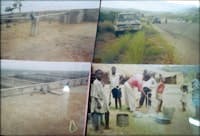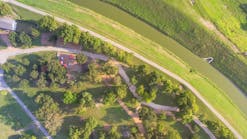With financial assistance from the World Bank, the Malawi government initiated a gravity-fed water supply scheme in the community of Dwambazi. The project, which includes more than 200 taps, benefits many community members and was co-financed by the Malawi government and communities, which contributed 5% of the total cost and provided labor for the excavation of pipeline trenches. A project management committee assisted in mobilizing the community to participate in the project.
Treatment System
Technically, the project comprised the intake structure in the form of a 15-meter concrete weir that was constructed across Dwambazi River on the hillside about 5 km away from the Dwambazi trading center. To ensure that people are supplied with clean water, the intake structure was constructed at a location that is free of human activities to avoid contamination. By working with traditional chiefs and district authorities, the project team established a bylaw that forbids any settlement or human activities—such as charcoal making or poaching—in any section above the intake to avoid water pollution. The intake pipe was fitted with a strainer so that debris could not pass through into the water conduits.
From the intake, another important stage was the water treatment and storage plant. Water passes through roughing filters—concrete structures in which large particles are trapped in the filter media. From the roughing filters, the water goes through slow sand filters, where biological treatment takes place. Slow sand filters are large in size, with finer particles than roughing filters. The size allows more detention time for the water to undergo treatment processes. A biological layer called schmutzdecke grows on the filter media, which provides a good environment for microbiological treatment of water.
After passing through treatment tanks, the water goes into a water storage tank that was constructed about 100 meters from the treatment plant. The tank allows for settlement of the finer sediments trapped in the water so more clarified water goes to consumers. From the tank, 160-mm-diameter PVC pipe was laid a distance of about 2 km to the Dwambazi trading center.
Communal & Private Taps
The Dwambazi water project was designed to have more communal water points than individual taps. According to Malawi government criteria for communal taps, one tap caters to 120 people or about 14 households, as one household has an average of five occupants. At tap points, communities contributed sand and bricks for construction of a slab around the tap. After the tap was constructed, the community chose a committee—designated the “tap point committee”—to take care of the tap on behalf of the tap beneficiary.
Although Malawi government policy is to provide free water to rural communities, the communities contribute money for sustainability of the water system that the government provides. The money is paid on a monthly basis and is collected by the communities themselves. Using the money, the community committees are able to buy spare parts for the water systems and pay artisans employed to service technical components of the system.
The main committee was the one responsible for daily administration of the water supply system after handovers. During construction, the committee worked with technical staff from the government’s Ministry of Water, which offered technical assistance.
The project’s main committee supervised smaller committees, such as tap point committees. To ensure the main committee had the required knowledge to manage the project. the Ministry of Water Development, through its Community Based Management section, organized a training workshop for community leaders and committees on how to manage the project. The ministry also provided a pickup truck for the project.
Successes & Failures
The project covered a distance of about 15 km to the northern part of Dwambazi into Nkhata-Bay district and about 10 km to the southern part into Nkhoto-Kota district.
Another success of the Dwambazi project was the community participation. The community was involved in the early stages of project planning, which is why it was easy for the community to actively participate in the entire project implementation stage. Community leaders could advise villagers on community work like the digging of pipeline trenches and the provision of sand for the construction of civil works.
Although the project was successfully implemented and the people now have water, there were some problems. The Ministry of Water pulled out quickly before the community-based main committee was empowered with resources to manage the project. As a result, no major improvements have been achieved since the project engineer stopped going to the site. The project vehicle was grounded and the committee did not even have money to service it. There was a power struggle among community committee members between those coming from the Nkhota-Kota side and Nkhata-Bay side.
The implementation of the Dwambazi water project demonstrated how important it is to train the community and ensure that they have the knowledge and resources to manage the project before pulling out of the area. Ultimately, however, it shows a success story of engaging communities in the implementation of projects.
Download: Here


